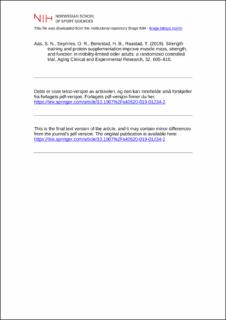| dc.contributor.author | Aas, Sigve Nyvik | |
| dc.contributor.author | Seynnes, Olivier R. | |
| dc.contributor.author | Benestad, Haakon Breien | |
| dc.contributor.author | Raastad, Truls | |
| dc.date.accessioned | 2020-06-24T09:11:24Z | |
| dc.date.available | 2020-06-24T09:11:24Z | |
| dc.date.created | 2019-08-07T12:51:09Z | |
| dc.date.issued | 2019 | |
| dc.identifier.citation | Aging Clinical and Experimental Research. 2019, 32, 605–616. | en_US |
| dc.identifier.issn | 1594-0667 | |
| dc.identifier.uri | https://hdl.handle.net/11250/2659262 | |
| dc.description | I Brage finner du siste tekst-versjon av artikkelen, og den kan inneholde ubetydelige forskjeller fra forlagets pdf-versjon. Forlagets pdf-versjon finner du på link.springer.com / In Brage you'll find the final text version of the article, and it may contain insignificant differences from the journal's pdf version. The definitive version is available at link.springer.com. | en_US |
| dc.description.abstract | Background Adaptation to strength training in very old mobility-limited individuals is not fully characterized. Therefore, the aim of this study was to perform a thorough investigation of the adaptation to a lower body strength training regime in this population, with particular emphasis on the relationship between changes in selected variables.MethodsTwenty-two mobility-limited older men and women (85 ± 6 years) were randomized to either a group performing 30 min of heavy-load strength training three times a week, with daily protein supplementation, for 10 weeks (ST), or a control group. End points were leg lean mass assessed by DXA, muscle thickness assessed by ultrasound, isometric and dynamic strength, rate of torque development, and functional capacity.ResultsLeg lean mass increased from baseline in ST (0.7 ± 0.3 kg), along with increased thickness of vastus lateralis (4.4 ± 3.2%), rectus femoris (6.7 ± 5.1%), and vastus intermedius (5.8 ± 5.9%). The hypertrophy was accompanied by improved knee extensor strength (20–23%) and functional performance (7–11%). In ST, neither the change in leg lean mass nor muscle thickness correlated with changes in muscle strength. However, a strong correlation was observed between the change in isometric strength and gait velocity (r = 0.70).ConclusionsThe mismatch between gains in muscle size and strength suggests that muscle quality-related adaptations con-tributed to the increases in strength. The correlations observed between improvements in strength and function suggests that interventions eliciting large improvements in strength may also be superior in terms of functional gains in this population. | en_US |
| dc.language.iso | eng | en_US |
| dc.subject | resistance exercise | en_US |
| dc.subject | frailty | en_US |
| dc.subject | sarcopenia | en_US |
| dc.subject | hypertrophy | en_US |
| dc.subject | mobility limited | en_US |
| dc.subject | skeletal muscle | en_US |
| dc.title | Strength training and protein supplementation improve muscle mass, strength, and function in mobility-limited older adults: a randomized controlled trial | en_US |
| dc.type | Peer reviewed | en_US |
| dc.type | Journal article | en_US |
| dc.description.version | acceptedVersion | en_US |
| dc.source.journal | Aging Clinical and Experimental Research | en_US |
| dc.identifier.doi | 10.1007/s40520-019-01234-2 | |
| dc.identifier.cristin | 1714602 | |
| dc.description.localcode | Seksjon for fysisk prestasjonsevne / Department of Physical Performance | en_US |
| cristin.ispublished | true | |
| cristin.fulltext | original | |
| cristin.fulltext | postprint | |
| cristin.qualitycode | 1 | |
